User’s Manual, V2.0, Mar. 2001
Instruction Set
Manual
for the C166 Family of
Infineon 16-Bit Single-Chip
Microcontrollers
Microcontrollers
N e v e r s t o p t h i n k i n g .
�
Edition 2001-03
Published by Infineon Technologies AG,
St.-Martin-Strasse 53,
D-81541 München, Germany
© Infineon Technologies AG 2001.
All Rights Reserved.
Attention please!
The information herein is given to describe certain components and shall not be considered as warranted
characteristics.
Terms of delivery and rights to technical change reserved.
We hereby disclaim any and all warranties, including but not limited to warranties of non-infringement, regarding
circuits, descriptions and charts stated herein.
Infineon Technologies is an approved CECC manufacturer.
Information
For further information on technology, delivery terms and conditions and prices please contact your nearest
Infineon Technologies Office in Germany or our Infineon Technologies Representatives worldwide.
Warnings
Due to technical requirements components may contain dangerous substances. For information on the types in
question please contact your nearest Infineon Technologies Office.
Infineon Technologies Components may only be used in life-support devices or systems with the express written
approval of Infineon Technologies, if a failure of such components can reasonably be expected to cause the failure
of that life-support device or system, or to affect the safety or effectiveness of that device or system. Life support
devices or systems are intended to be implanted in the human body, or to support and/or maintain and sustain
and/or protect human life. If they fail, it is reasonable to assume that the health of the user or other persons may
be endangered.
�
User’s Manual, V2.0, Mar. 2001
Instruction Set
Manual
for the C166 Family of
Infineon 16-Bit Single-Chip
Microcontrollers
Microcontrollers
N e v e r s t o p t h i n k i n g .
�
C166 Family Microcontroller Instruction Set Manual
Revision History:
Previous Version:
V2.0, 2001-03
Version 1.2, 12.97
Version 1.1, 09-95
03.94
Subjects (major changes since last revision)
Converted to new company layout
Overview- and summary-tables reformatted
List of derivatives updated
Description template added
PSW image added
Condition code table moved
Note for MUL/DIV added
Immediate data for byte instructions corrected to #data8
Note improved
Description of operation corrected
Description of division instructions improved
Format description corrected
Description improved
Description of multiplication instructions improved
Description of flags corrected
“bitoff” for ESFRs added
Section moved
Target address for “rel” corrected
General description improved
Timing examples converted to 25 MHz
Branch execution times corrected
Keyword index introduced
Page
all
4 … 30
2
31
34
38
40
42ff
52f
62
72ff
85
86
101f
128
132
137
139
141
142ff
143
148f
We Listen to Your Comments
Any information within this document that you feel is wrong, unclear or missing at all?
Your feedback will help us to continuously improve the quality of this document.
Please send your proposal (including a reference to this document) to:
mcdocu.comments@infineon.com
�
Table of Contents
C166 Family
Instruction Set
Page
1
2
3
3.1
3.2
3.3
3.4
3.5
4
5
6
6.1
6.2
6.3
6.4
6.5
6.6
6.7
7
7.1
7.2
7.3
8
Introduction . . . . . . . . . . . . . . . . . . . . . . . . . . . . . . . . . . . . . . . . . . . . . . . . 1
Overviews . . . . . . . . . . . . . . . . . . . . . . . . . . . . . . . . . . . . . . . . . . . . . . . . . . 3
Summary . . . . . . . . . . . . . . . . . . . . . . . . . . . . . . . . . . . . . . . . . . . . . . . . . . 8
Data Addressing Modes . . . . . . . . . . . . . . . . . . . . . . . . . . . . . . . . . . . . . . 8
Branch Target Addressing Modes . . . . . . . . . . . . . . . . . . . . . . . . . . . . . . 8
Multiply and Divide Operations . . . . . . . . . . . . . . . . . . . . . . . . . . . . . . . . . . 9
Extension Operations . . . . . . . . . . . . . . . . . . . . . . . . . . . . . . . . . . . . . . . . 9
Branch Condition Codes . . . . . . . . . . . . . . . . . . . . . . . . . . . . . . . . . . . . . . 9
Encoding . . . . . . . . . . . . . . . . . . . . . . . . . . . . . . . . . . . . . . . . . . . . . . . . . 22
Detailed Description . . . . . . . . . . . . . . . . . . . . . . . . . . . . . . . . . . . . . . . . 31
Addressing Modes . . . . . . . . . . . . . . . . . . . . . . . . . . . . . . . . . . . . . . . . . 132
Short Addressing Modes . . . . . . . . . . . . . . . . . . . . . . . . . . . . . . . . . . . . . 132
Long Addressing Mode . . . . . . . . . . . . . . . . . . . . . . . . . . . . . . . . . . . . . . 134
Indirect Addressing Modes . . . . . . . . . . . . . . . . . . . . . . . . . . . . . . . . . . . 135
DPP Override Mechanism . . . . . . . . . . . . . . . . . . . . . . . . . . . . . . . . . . . . 137
Constants within Instructions . . . . . . . . . . . . . . . . . . . . . . . . . . . . . . . . . . 138
Instruction Range (#irang2) . . . . . . . . . . . . . . . . . . . . . . . . . . . . . . . . . . . 138
Branch Target Addressing Modes . . . . . . . . . . . . . . . . . . . . . . . . . . . . . . 139
Instruction State Times . . . . . . . . . . . . . . . . . . . . . . . . . . . . . . . . . . . . . 141
Time Unit Definitions . . . . . . . . . . . . . . . . . . . . . . . . . . . . . . . . . . . . . . . . 142
Minimum Execution Time . . . . . . . . . . . . . . . . . . . . . . . . . . . . . . . . . . . . 143
Additional State Times . . . . . . . . . . . . . . . . . . . . . . . . . . . . . . . . . . . . . . . 145
Keyword Index . . . . . . . . . . . . . . . . . . . . . . . . . . . . . . . . . . . . . . . . . . . . 148
User’s Manual
V2.0, 2001-03
�
C166 Family
Instruction Set
Introduction
Introduction
1
The Infineon C166 Family of 16-bit microcontrollers offers devices that provide various
levels of peripheral performance and programmability. This allows to equip each specific
application with the microcontroller that fits best to the required functionality and
performance.
Still the Infineon family concept provides an easy path to upgrade existing applications
or to climb the next level of performance in order to realize a subsequent more
sophisticated design. Two major characteristics enable this upgrade path to save and
reuse almost all of the engineering efforts that have been made for previous designs:
All family members are based on the same basic architecture
All family members execute the same instructions
(except for upgrades for new members)
The fact that all members execute basically the same instructions saves know-how with
respect to the understanding of the controller itself and also with respect to the used tools
(assembler, disassembler, compiler, etc.).
This instruction set manual provides an easy and direct access to the instructions of the
Infineon 16-bit microcontrollers by listing them according to different criteria, and also
unloads the technical manuals for the different devices from redundant information.
This manual also describes the different addressing mechanisms and the relation
between the logical addresses used in a program and the resulting physical addresses.
There is also information provided to calculate the execution time for specific instructions
depending on the used address locations and also specific exceptions to the standard
rules.
Description Levels
In the following sections the instructions are compiled according to different criteria in
order to provide different levels of precision:
Cross Reference Tables
summarize all instructions in condensed tables
The Instruction Set Summary
groups the individual instructions into functional groups
The Opcode Table
references the instructions by their hexadecimal opcode
The Instruction Description
describes each instruction in full detail
User’s Manual
1
V2.0, 2001-03
�
C166 Family
Instruction Set
Introduction
All instructions listed in this manual are executed by the following devices (new
derivatives will be added to this list):
C161K, C161O, C161PI
C161CS, C161JC, C161JI
C163
C164CI, C164SI, C164CM, C164SM
C165
C167CR, C167SR
C167CS
A few instructions (ATOMIC and EXTended instructions) have been added for these
devices and are not recognized by the following devices from the first generation of 16-
bit microcontrollers:
SAB 80C166, SAB 80C166W
SAB 83C166, SAB 83C166W
These differences are noted for each instruction, where applicable.
User’s Manual
2
V2.0, 2001-03
�
C166 Family
Instruction Set
Overviews
2
The following compressed cross-reference tables quickly identify a specific instruction
and provide basic information about it.
Two ordering schemes are included:
The hexadecimal opcode of a specific instruction can be quickly identified with the
Overviews
respective mnemonic using the first compressed cross-reference table.
The mnemonics and addressing modes of the various instructions are listed in the
second table. The table shows which addressing modes may be used with a specific
instruction and also the instruction length depending on the selected addressing
mode. This reference helps to optimize instruction sequences in terms of code size
and/or execution time.
Both ordering schemes (hexadecimal opcode and mnemonic) are provided in more
detailed lists in the following sections of this manual.
Note: The ATOMIC and EXTended instructions are not available in the SAB 8XC166(W)
devices.
They are marked in the cross-reference table.
User’s Manual
3
V2.0, 2001-03
�
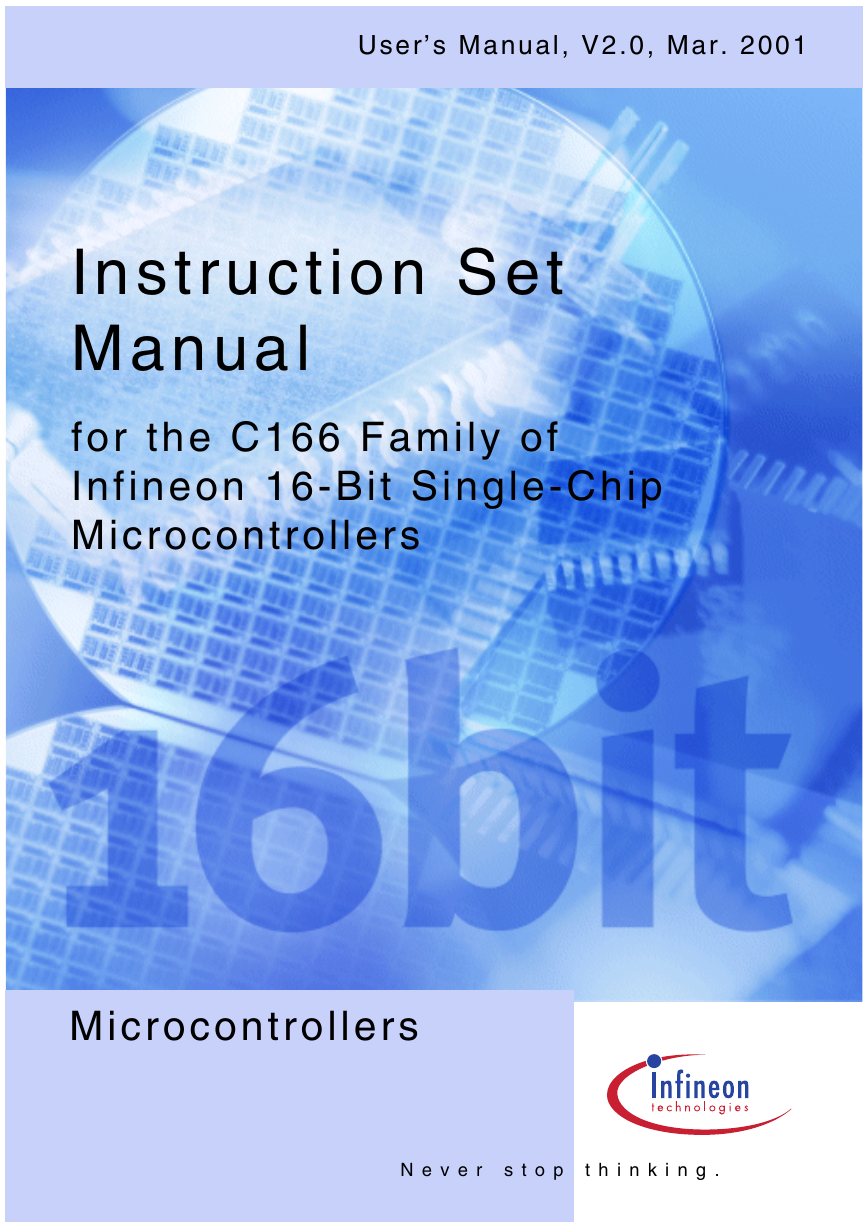
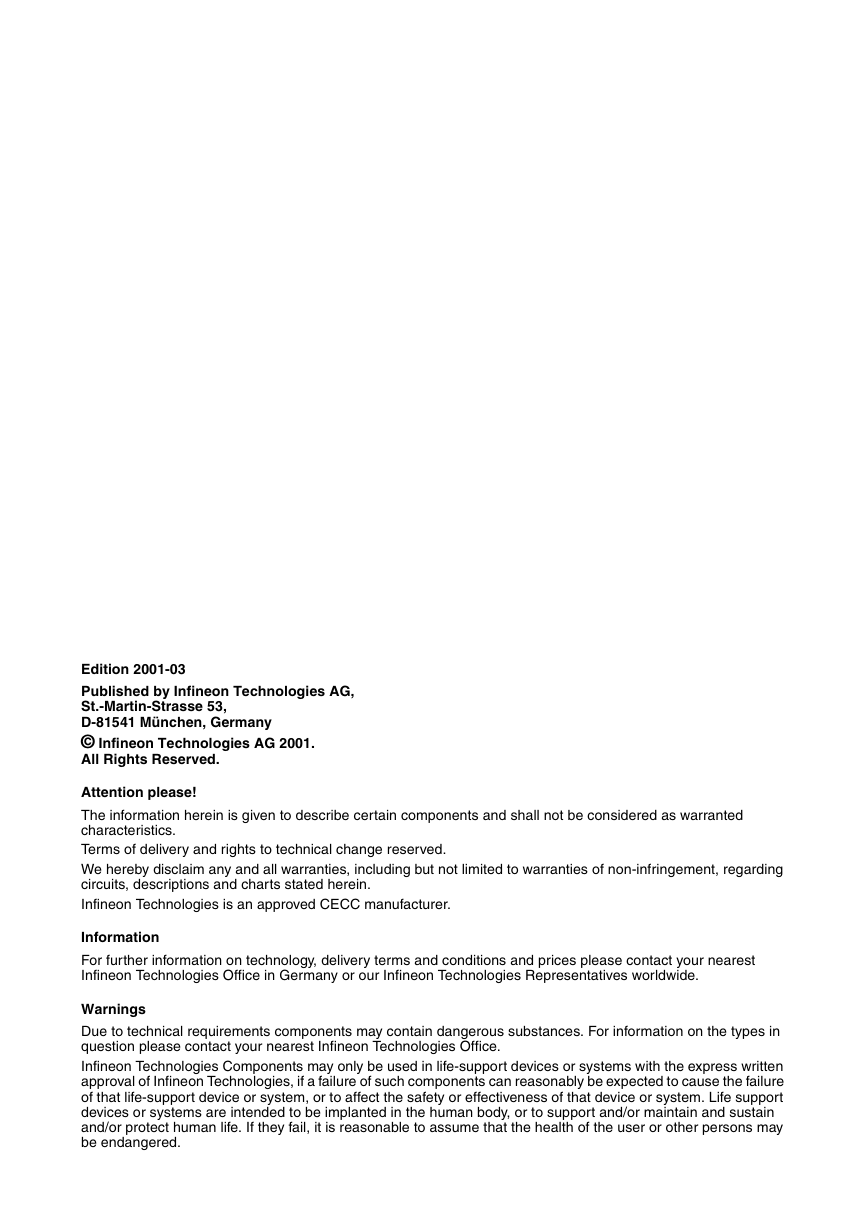
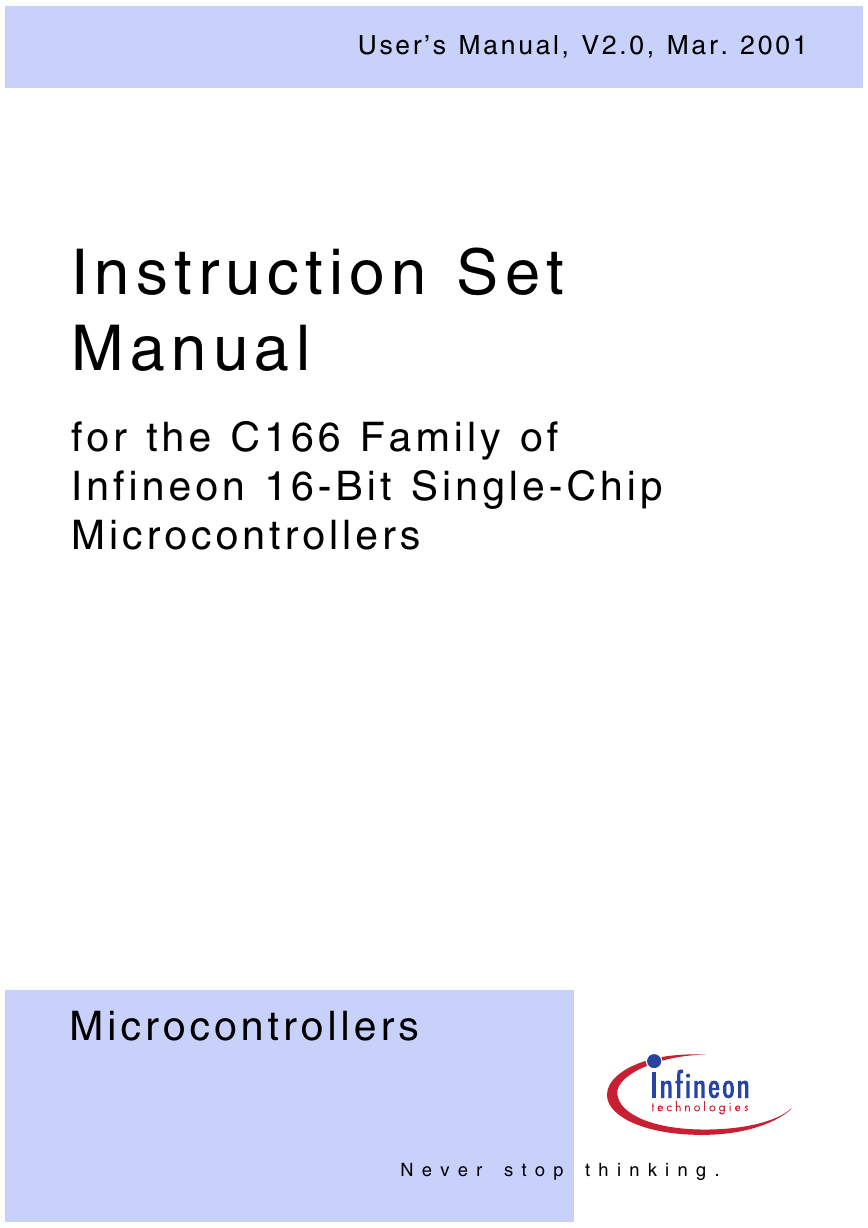

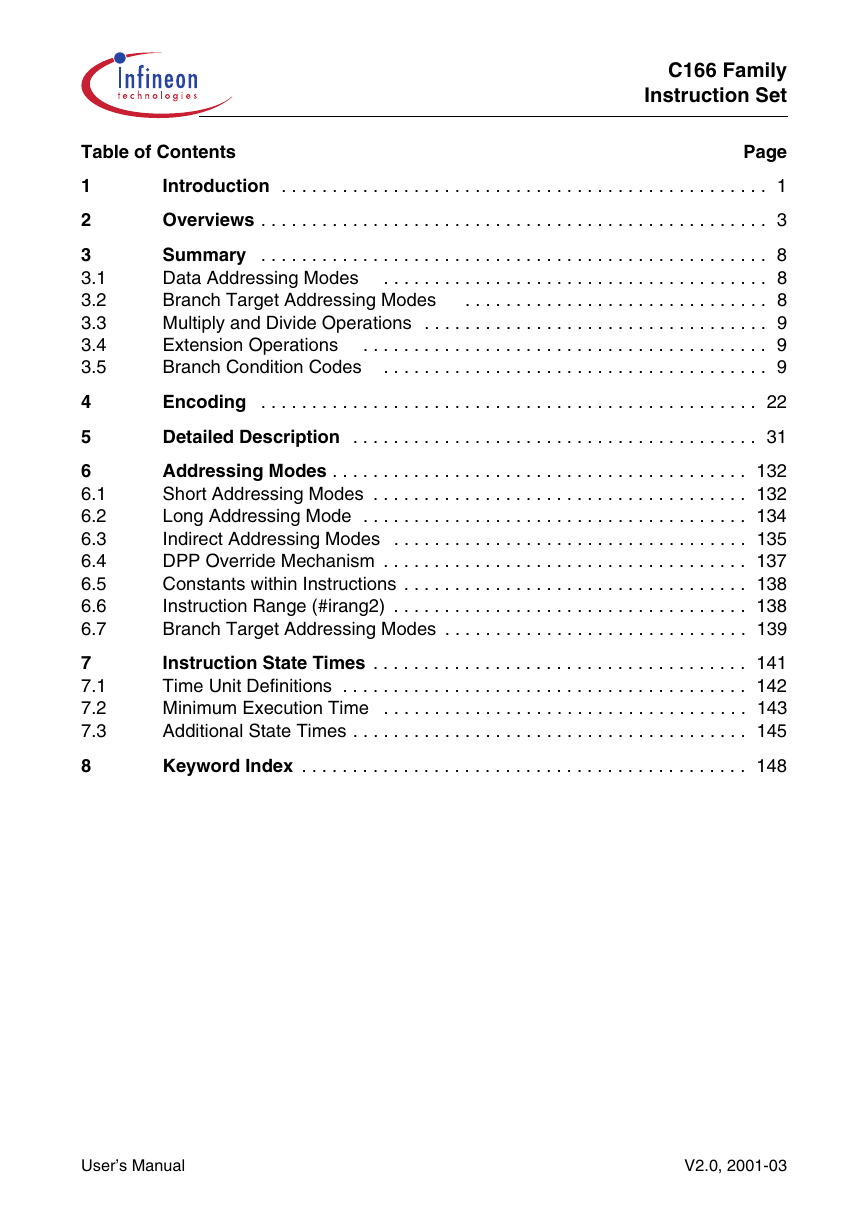


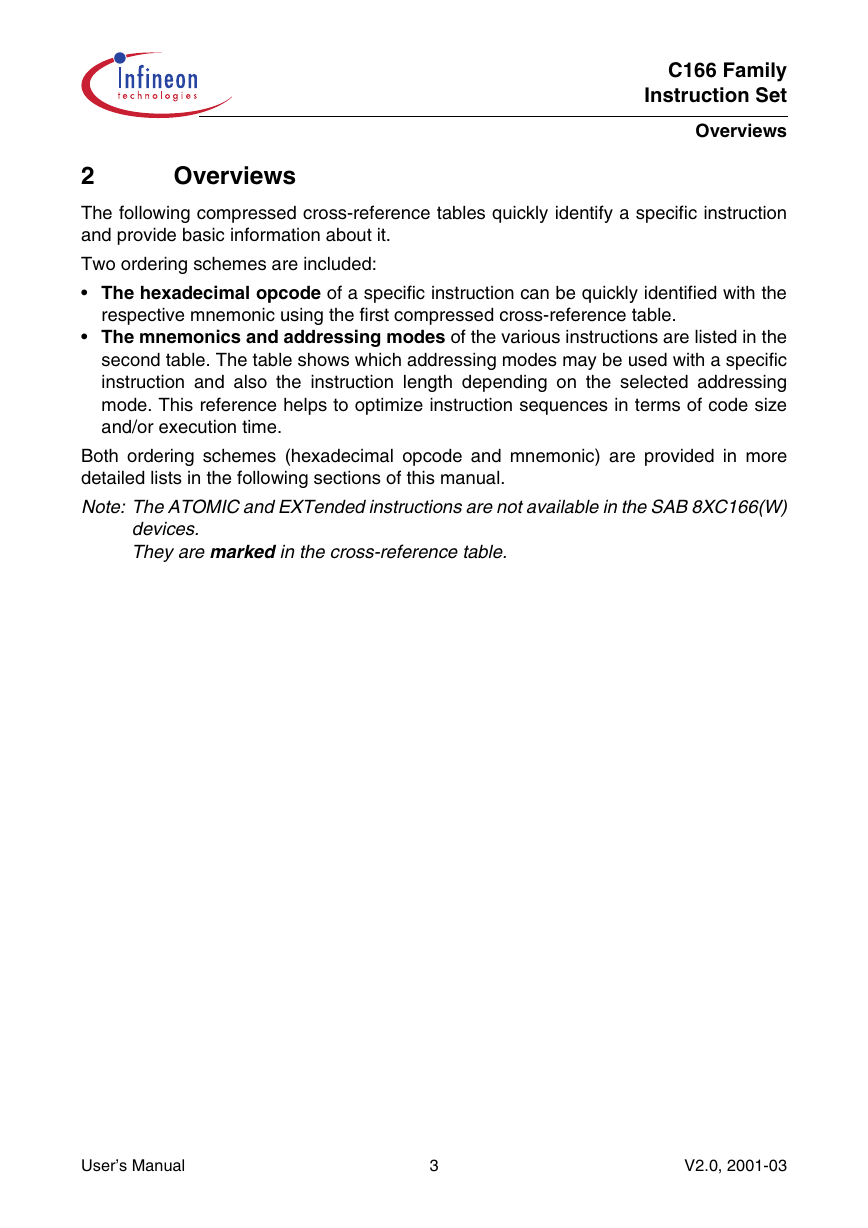








 2023年江西萍乡中考道德与法治真题及答案.doc
2023年江西萍乡中考道德与法治真题及答案.doc 2012年重庆南川中考生物真题及答案.doc
2012年重庆南川中考生物真题及答案.doc 2013年江西师范大学地理学综合及文艺理论基础考研真题.doc
2013年江西师范大学地理学综合及文艺理论基础考研真题.doc 2020年四川甘孜小升初语文真题及答案I卷.doc
2020年四川甘孜小升初语文真题及答案I卷.doc 2020年注册岩土工程师专业基础考试真题及答案.doc
2020年注册岩土工程师专业基础考试真题及答案.doc 2023-2024学年福建省厦门市九年级上学期数学月考试题及答案.doc
2023-2024学年福建省厦门市九年级上学期数学月考试题及答案.doc 2021-2022学年辽宁省沈阳市大东区九年级上学期语文期末试题及答案.doc
2021-2022学年辽宁省沈阳市大东区九年级上学期语文期末试题及答案.doc 2022-2023学年北京东城区初三第一学期物理期末试卷及答案.doc
2022-2023学年北京东城区初三第一学期物理期末试卷及答案.doc 2018上半年江西教师资格初中地理学科知识与教学能力真题及答案.doc
2018上半年江西教师资格初中地理学科知识与教学能力真题及答案.doc 2012年河北国家公务员申论考试真题及答案-省级.doc
2012年河北国家公务员申论考试真题及答案-省级.doc 2020-2021学年江苏省扬州市江都区邵樊片九年级上学期数学第一次质量检测试题及答案.doc
2020-2021学年江苏省扬州市江都区邵樊片九年级上学期数学第一次质量检测试题及答案.doc 2022下半年黑龙江教师资格证中学综合素质真题及答案.doc
2022下半年黑龙江教师资格证中学综合素质真题及答案.doc